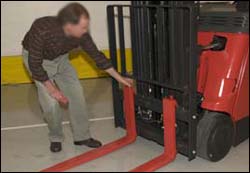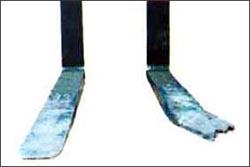Powered Industrial Trucks (Forklift) eTool
Parts » Forks

The forks (also known as tines or blades) carry the load. They have a heel where they curve upward and an upright shank where they are attached to the carriage.
Forks

Potential Hazards
A fork that shows any of the following defects shall be withdrawn from service and discarded or properly repaired:
-
Surface cracks.
-
Blade or shank are not straight.
-
Fork angle from blade to shank is not straight.
-
Difference in height of fork tips.
-
Positioning lock not in working order.
-
Fork blade or shank wear.
-
Fork hooks wear.
-
Fork marking not legible.
Requirements and Recommended Practices
-
Do not operate the forklift if the forks show any of the defects listed above.
-
Always inspect forks during the pre-operation inspection. Repair or replace the forks if they are not in good working order. Replacement parts shall be equivalent as to safety with those used in the original design. [29 CFR 1910.178(q)(5)]
-
Do not operate a forklift from which the positioning lock has been removed or is inoperable. As the forklift travels, the positioning lock holds the forks in position and prevents sliding of the forks and loss of the load.
Additional Information
-
Fork inspection requirements for powered industrial trucks. OSHA Standard Interpretation, (October 22, 1999).

